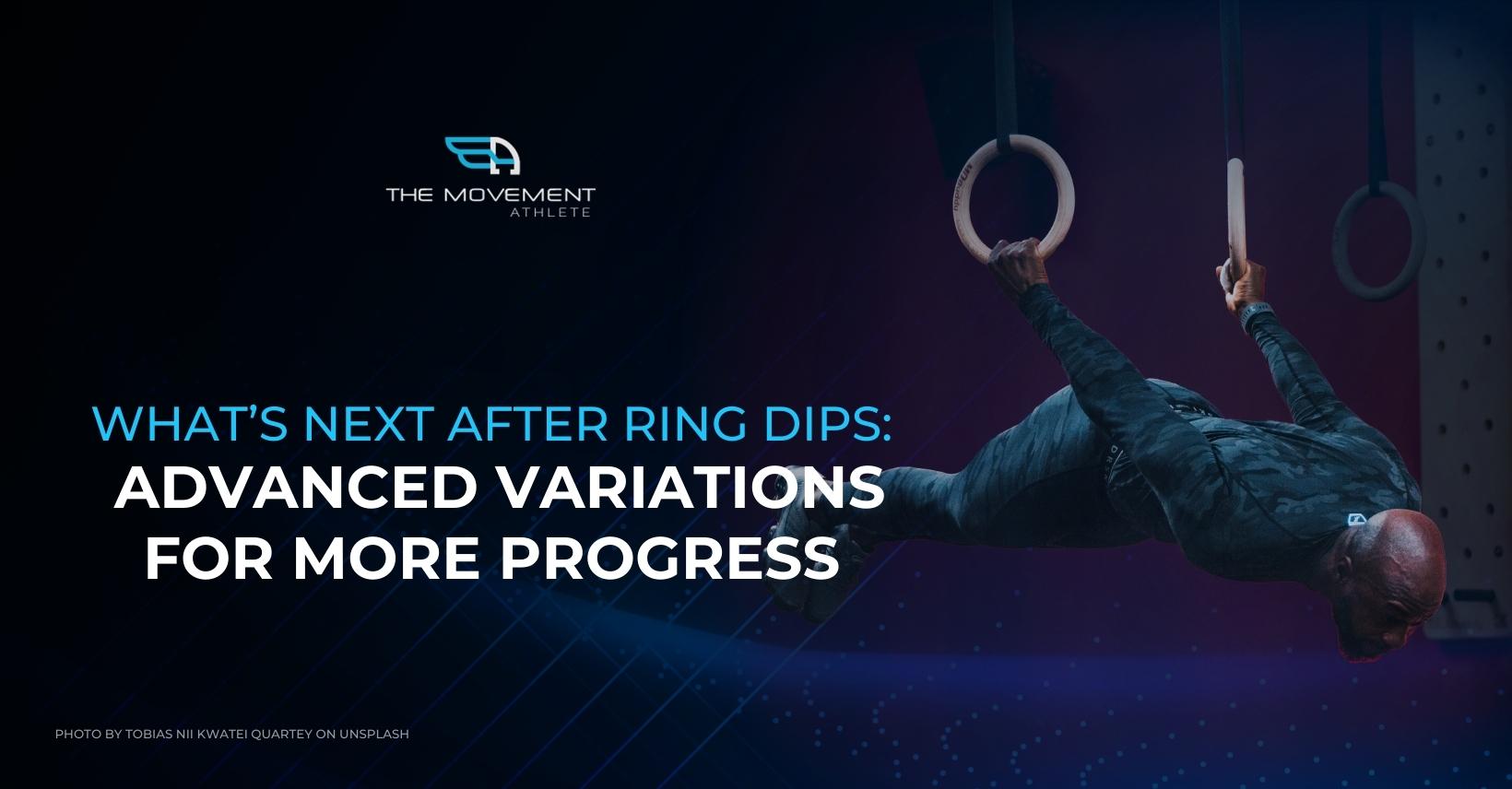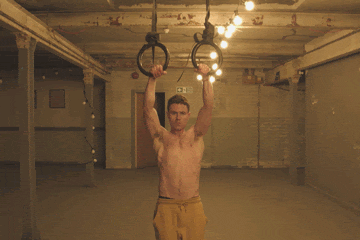

📖 Read Time: 8 Minutes
🏋️ Join the tribe of Movement & Calisthenics Athletes
People just like you that are working with their own body weight to get strength, lose fat, build muscle, recover from injuries and live their best lives!
There’s plenty more to go once you have unlocked ring dips! 💯
Mastering the ring dip sets you with a solid base of general pushing strength, straight-arm and shoulder stability, upper body mobility, and control. In addition, the developed foundation opens so many combinations to work with and unlocks harder variation so you can continue to grow stronger than ever.
☝️ Make sure you have surely mastered ring dips with perfect form before trying out these advanced upper body exercises below.
📍 How to unlock ring dips: understanding the prerequisites and muscles used
When you can easily perform 4 sets of 10 ring dips, you can move towards these advanced variations.
💥 Just keep in mind that ring dips aren’t the only prerequisites for most of the exercises below. So don’t worry, as we will cover each exercise so you can safely and efficiently learn these fun advanced transitions.
Ready to take your ring training to the next level? Take our free assessment to get a personalized training plan that builds toward these advanced skills.
🔥 Dip to Back Lever
This exercise is a combination of a dip then transition into a back lever after the lowering phase of the dip. Obviously, one requirement, other than ring dip mastery, is an excellent back lever.
This combination helps you target more of your biceps and back once you finish the dip component, which targets the triceps and chest.
One thing to note about this transition is being aware of the change from the scapula retraction from the ring dip into a scapula protraction during the back lever hold. Scapular position change keeps you stabilized throughout the movement pattern.
🔥 Back Kip
Back kip is a very fun variation that requires much control because of the momentum involved. This is quite an explosive skill that requires great shoulder extension and bicep strength for catching the lowered phase.
Let’s first cover how to learn to use the momentum with a kip to support hold.
From a dead hang position with a false grip, you shift your weight backward into a vertical hang. Fold your pike into 45 degrees with your body horizontal to the ground, then swing your leg outward to 45 degrees again. Use the momentum gained from the kip as you pull your body upward into a support hold position.
Because of the momentum involved and false grip placement, it’s ideal to have ring muscle-up mastery as well.
Now for the actually back kip, from the dead hang with a false grip, begin to kip, but instead of shooting forward, you will shoot backward, mimicking a shoulder dislocate. This is what I’m talking about requiring excellent shoulder mobility. From the backward kip, continue pushing down to achieve the support dip hold.
Be sure to train the first variation before training with the back dip. Ideally, you would want a spotter when first learning the skill.
🔥 Bulgarian Dip
Bulgarian dip is basically a ring dip, but you go wider, and you have to rotate your arms as you lower down internally. This wide stance at the bottom promotes a stretch reflex, and the internal rotation adds a squeezing motion targeting the chest even harder.
The basic foundation of the ring dip technique still follows—lockout position at the support hold. Lower down to 90-degrees. Shoulders depressed and retracted. Keep the elbows within the scapular plane, meaning that keep them slightly behind your shoulders.
The Bulgarian dip is excellent for building a bigger and stronger chest and triceps using the rings and not adding any weights.
🔥 Forward Roll to Support
This exercise is similar to the first progression of the back kip, but you don’t have to use momentum when transitioning to support hold.
From a support hold position, dip, then roll forward while keeping your hands close to your chest. This means you should be in a false grip position to maintain your hands close to the body. Once you complete a roll, you should be at the bottom part of a dip, then just press back to support hold position.
This fun exercise requires a solid ring muscle-up to easily transition back to the support hold because the bottom position of the forward roll is very similar to the transitional phase of the pull-up to the dip phase of the muscle-up.
🔥 L-dips
The L-dips are quite similar to the regular ring dip technique but with one difference: leg position. In the L-dips, you must maintain your legs parallel to the ground like what you would do when holding an L-sit.
The obvious difference would be an increase in core engagement but it isn’t the major factor why the exercise is much more difficult than the regular dip. The forward position of the legs moves your center of mass to the front, which requires you to push a greater load from the bottom back to support hold.
The same technique applies with regular dips. Just don’t let your legs dip lower and keep them parallel to the ground.
🔥 Planche Push-ups
Although not a dip, the planche push-up has a bit of similarity with the ring dips. For one, they are both pushing exercises. Two, their top position requires straight arms. This means that training ring dips have strength transfer to the planche push-ups.
But this is not a direct transfer. You can’t master ring dips, then try planche push-ups immediately. I mean, you can, but you will surely fail.
If you want to train planche push-ups, you must train the planche hold first. Mastering the isometric hold at the top position allows you to perform the whole planche push-up motion with good form. You also don’t have to rush to full planche immediately. Develop your strength by studying and mastering the planche progression.
For more planche help, check out our ultimate planche guide.
🔥 Press to Shoulder Stand
Here’s another fun exercise that looks so cool! For this one, you need to have a solid support hold. Mastery on this can transfer to the shoulder stand, which requires stability. This is an introductory exercise to other advanced ring transitions and flow.
From the support hold, bend your arms, and lean forward. As you put more weight unto your deltoids, press your hips until it is diagonal then press your legs upward to complete the shoulders stand.
In the shoulder stand, keep your shoulders in front of the hands and the hands stacked on your elbows. Depress your shoulders and keep your legs engaged and together. Pointing the toes help in global body tension.
When first learning the shoulder stand, you can first keep your legs tucked then gradually straighten your legs as you gain more control over this inverted position.
🔥 Explosive Dips
Once you have maximum control over the ring dip, you can play with explosive rings to increase your power. The explosiveness added to the exercises generates momentum, which might make your rings sway. Keep intact with solid form.
Now you don’t have to perform the full motion explosively. You can lower down with control then explosively push back to support hold position.
The power you gain from this exercise can translate to other ring movements and transitions that require explosiveness, such as transitioning to planche from a ring muscle-up.
🔥 Muscle-up

If you have mastered the regular ring dips, you already have unlocked one-third of the ring muscle-up. So what’s the remaining two-thirds, you might ask.
The other one-third is obviously the pull-up which must be done with a false grip in order to transition well from the pull-up to the dip.
The other one-third is the transition itself. Once you have unlocked the ring dip and pull-up, you already have the base strength for the ring muscle-up. All it is left is learning the transition, which requires skill and familiarity with the motion.
The transition may feel very awkward at the beginning, even if you already have the base strength for a muscle-up. To train for it without fatiguing too early, you can decrease the intensity by practicing only the transition with leg assistance. This allows you to memorize the feeling of the movement.
Want to master the muscle-up? Download our complete muscle-up training plan for step-by-step progressions.
💡 Key Takeaway: Mastering the ring dip is a great achievement, but your training journey won’t end there. There is another level of goals you can train for next.
You will not get tired of learning new movements as there is various, fun, and challenging movement patterns you can train for once you have gotten the ring dips down.
But before attempting these advanced exercises, be sure that you have complete mastery of the prerequisites of the exercises as well as you should already have developed your fundamentals.
👊 To know if you are ready to take on these advanced challenges, or if even you are ready to train for ring dips, be sure to understand your body’s current capabilities. You can do this by following a simple assessment so you can know where you are in your fitness journey and better choose how to move forward with your training.
Related Articles You’ll Love:
Ready to get started?
Get your free personalized training plan now
